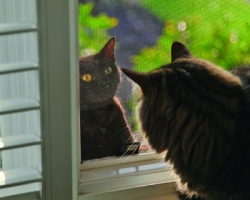Growing up, my high school mascot was the wildcat. Being a cheerleader, I had wildcat images all over the place. Now I have actual wild cats all over my lawn. Who knew that my high school mascot would one day hold even more importance?
I never really gave feral cats much thought. I’d see cats walking down my street but thought they all had homes and were just outdoor cats. I should have known, though, because both Francis and Peanut were local strays that found their way into our house. Do you think the bowl of food I leave on my porch had anything to do with that? I was floored to learn that there were colonies of wild cats all over Culver City.
About two years ago I started feeding a cute and very timid black cat. I felt so bad for him because he was terrified of people and wouldn’t get anywhere near me. And yet, he’d sit on my porch and meow at my indoor cats, Francis and Enzo. He was skinny and looked like he had been in a catfight or two because his ear was missing the tip. What I didn’t know is that a clipped ear is the universal sign that a feral cat that has been caught, neutered and released. It makes sense that there would be a sign so that everyone might know that he wasn’t contributing to the pet overpopulation problem. Sammy, as I came to call him, has come a long way but still won’t let a human near. He loves Enzo, however, and will come inside to see him. I learned the hard way never to close the door.
So who takes care of these local feral cats? There are definitely many Good Samaritan-types out there who feed a random stray or two, but I always wondered if there was a rescue organization that specialized in wild cats. Of course there is and it’s called the Feral Cat Caretakers’ Coalition (FCCC). The nonprofit was formed in by founder, Dona Cosgrove Baker, who said she was “profoundly moved by the suffering of feral cats and kittens.”
There was a lack of support and understanding from the community as well. Cosgrove Baker said she realized that if feral cat caretakers were organized and collectively supported, they would be a forceful instrument in providing a specialized solution for humane feral cat population control and responsible, long-term care.
A large part of the FCCC’s focus is controlling the overpopulation. Baker says that the costs associated with the trapping and euthanasia of feral cats are “prohibitive” to local governmental agencies. “Because of their undomesticated nature, feral cats are not considered adoptable and are routinely destroyed in city and county animal shelters. Killing feral cats is inhumane as well as costly, and does not solve the problem. The method of trapping, neutering and returning has been accepted and endorsed by municipal agencies, animal welfare organizations and the California Veterinary Association as the only successful, proven way to solve the problem of feral cat overpopulation,” she says.
That’s why Sammy’s ear has been clipped. Now the volunteers know that he has been trapped and neutered, and they can do the same for another cat.
According to an FCCC spokesperson, “Solving the overpopulation of feral cats and improving their lives depends upon the dedication and commitment of caretakers. In turn, the caretakers’ success in achieving these goals requires support, services, training, networking and supplemental resources to provide quality feral cat care and acceptable long-term care alternatives.”
The organization will host a workshop to teach volunteers how to help tackle the feral cat overpopulation problem. Anyone interested in helping is urged to go to FeralCatCaretakers.org.













